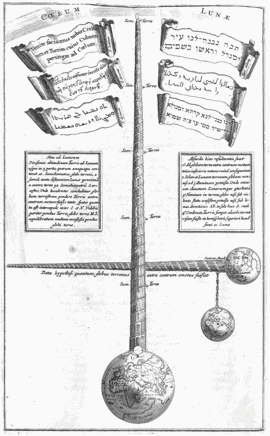
If the Earth has never been shy about proclaiming the instability of its surface, the creature misnamed Homo sapiens has never been shy about ignoring the message. Dubai’s 828 meter-tall Burj Khalifa skyscraper, which opened in early January, is only the latest in a millennial series of contenders for the title of world’s tallest building. It looms, at least for now, above Malaysia’s Petronas Towers, Toronto’s CN Tower, Chicago’s Sears Tower, and the quaintly venerable Empire State Building in that proverbial city of towers, New York. Yet the profile of Burj Khalifa suggests nothing so much as a seventeenth-century engraving intended to ridicule the human habit of tower-building, part of the German Jesuit Athanasius Kircher’s exquisitely illustrated essay on the Tower of Babel, Turris Babel of 1679.
Kircher was interested in nearly everything, including the length of the Biblical cubit, and the Tower of Babel was one of his points of reference for establishing precisely what that length might have been. But Kircher’s image calls into question more than the measure of the cubit. Officially, for a Jesuit father in Rome in 1679, Earth’s proper place was the center of the universe—a locus from which it could not be easily dislodged. But his picture illustrates how an overly massive tower would have done just that. In the foreground we see a Tower of Babel reaching from the sphere of the Earth up to scrape the sphere of the Moon (COELUM LUNAE); fluttering around its upper reaches are versions of Genesis 11:4 —“Go to, let us build us a city and a tower, whose top may reach unto heaven”—in six languages (Latin, Greek, Syriac, Hebrew, Arabic, and Aramaic, all of which Kircher knew). The two long boxed captions on either side of the tower, meanwhile, explain the background image: it shows (as per the “Note to the Reader” in the left-hand panel) that a tower of that height “when balanced against the earthly globe … greatly exceeds the weight of the earthly globe itself.” Hence Planet Earth hangs dramatically on a chain from the center of gravity that would obtain for a combination of Earth plus moon-scraping tower.

But how can the center of the universe be knocked off center? As the right-hand panel helpfully remarks, “These results are absurd,” enumerating reasons that include “the movement of the earthly globe out of its center would bring on the ruin of all nature below”, “the Sun and the Moon could no longer illuminate the earthly globe”, and “No one could exist on the Earth except in a violent state.” In truth, the more we examine it, the more Kircher’s whole page looks like a colossal phallic joke—especially from a man who also wrote obsessively about obelisks. If we listen carefully we can probably still hear the old trickster, nearly eighty when this book was published, cackling with delight.
The phallic nature of towers has never been subject to much doubt. Medieval Italian cities bristled with them, each one symbolizing, with what the Greek poet Pindar called (in another phallic context) “upright hubris,”* a powerful family or clan. Bologna at the time of Dante in the early fourteenth century was as full of skyscrapers as New York.
Difficult to access and structurally unsound, the upper reaches of these structures served no real purpose other than ostentation and were wasteful in the extreme (perhaps Father Kircher was right after all about living in a violent state). They embodied the kind of destructive feuding that we see in the Verona of Romeo and Juliet, they cost inordinate amounts of money, and they came tumbling down with disconcerting frequency in a terrain riddled with the craters of ancient volcanoes and crisscrossed by fault lines. Verona’s towers crashed to earth in a medieval earthquake. The sudden change in color at a certain level of Siena’s Mangia tower marks an eighteenth-century collapse. The Campanile that dominates Piazza San Marco in Venice is a modern reconstruction; the original crumbled to a heap in 1902.

Why, then, do we keep building to such heights? To be sure, it is in the nature of phallic things (symbols included) to try, try, and try again, just as it is in the nature of primates, among other artists, to imitate all that they admire, including marvelous tall majesties like mountains and trees. But ultimately, as Father Kircher suggested, there are physical limits to the most ingenious human striving. As more and more women join the ranks of practicing architects, as well as the ranks of those who commission architecture, perhaps we will see a change in the ideal form of buildings and cities. (For one example, see Jeanne Gang’s new wind-baffling, undulating skyscraper in Chicago.) Certainly the great architectural matrons of the Italian Baroque era, like the Neapolitan princess Isabella Feltria della Rovere, wasted no time erecting towers—instead, while her feckless husband languished in debtor’s prison, she poured her fortune into the great marble-encrusted Jesuit Church of Gesù Nuovo, reserving a place for her own tomb at the high altar. That, at least, was an architectural scheme that the Jesuit Father Athanasius Kircher would have endorsed with wholehearted enthusiasm.
Advertisement
∗ Pindar, Pythian Ode 10.36, referring to the donkeys of the legendary Hyperboreans: γελᾷ θ᾽ ὁρῶν ὕβριν ὀρθίαν κνωδάλων Apollo “laughs, seeing the upright hubris of the beasts.”


